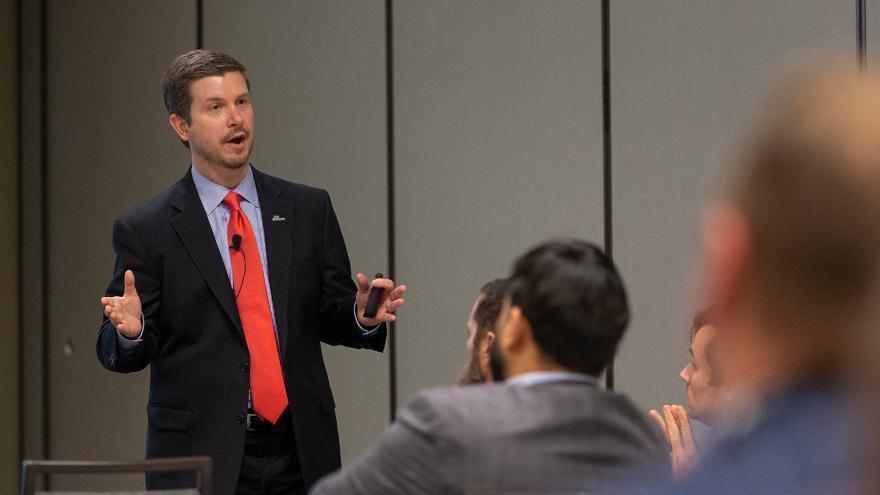Cox Automotive & NAFCU examine latest Federal Reserve actions

File photo of Cox Automotive chief economist Jonathan Smoke speaking at the Auto Intel Summit. Photo by Jonathan Fredin / Cherokee Media Group.
By subscribing, you agree to receive communications from Auto Remarketing and our partners in accordance with our Privacy Policy. We may share your information with select partners and sponsors who may contact you about their products and services. You may unsubscribe at any time.
CARY, N.C. –
Experts from Cox Automotive and the National Association of Federally-Insured Credit Unions (NAFCU) each digested actions and comments by the Federal Reserve on Wednesday after the Federal Open Market Committee (FOMC) voted unanimously to keep interest rates unchanged.
Both experts honed in on how policymakers offered a glimpse about when their strategy could change to modify the target range for the federal funds rate that currently sits at 0 to 0.25%.
“Today, the Federal Open Market Committee kept interest rates near zero and maintained our asset purchases. These measures, along with our strong guidance on interest rates and on our balance sheet, will ensure that monetary policy will continue to deliver powerful support to the economy until the recovery is complete,” chair Jerome Powell said during his opening comments of a press conference on Wednesday following the Fed’s latest action.
“Widespread vaccinations, along with unprecedented fiscal policy actions, are also providing strong support to the recovery,” Powell continued. “Indicators of economic activity and employment have continued to strengthen, and real GDP this year appears to be on track to post its fastest rate of increase in decades. Much of this rapid growth reflects the continued bounce back in activity from depressed levels. The sectors most adversely affected by the pandemic remain weak, but have shown improvement.”
After Powell offered his initial assessments, NAFCU chief economist and vice president of research Curt Long issued this statement that focused on the forward-looking parts of the chair’s remarks.
“As expected, the Fed moved forward its expected date for liftoff to 2023, and more than one-third of the committee believes it will occur in 2022,” Long said. “The inflation forecast increased for the current year, but not beyond. It appears that the change in the outlook for rate increases was motivated by dissipating downside risks resulting from progress in vaccine distribution, rather than the recent rise in price growth.”
Subscribe to Auto Remarketing to stay informed and stay ahead.
By subscribing, you agree to receive communications from Auto Remarketing and our partners in accordance with our Privacy Policy. We may share your information with select partners and sponsors who may contact you about their products and services. You may unsubscribe at any time.
In anticipation of being asked about how the FOMC is approaching its decision-making process, Powell offered these thoughts.
“Of course, these projections do not represent a committee decision or plan, and no one knows with any certainty where the economy will be a couple of years from now. More important than any forecast is the fact that, whenever liftoff comes, policy will remain highly accommodative,” Powell said.
“Reaching the conditions for liftoff will mainly signal that the recovery is strong and no longer requires holding rates near zero,” he added.
Of course, dealerships need to retail vehicles and finance companies need to fill their portfolios with quality paper now, as well as in 2022 and 2023. Cox Automotive chief economist Jonathan Smoke offered his observations about not only the current state of auto financing, but also how it is connected back to the Fed’s actions.
“Consumer loans like auto loans and mortgages are more directly related to these longer-term yields rather than the Fed’s short-term rate policy,” Smoke wrote in a company blog post. “The 10-year yield was up about 66 basis points during chairman Powell’s press conference compared to the end of last year.
“However, consumer rates on auto loans have not moved up so far this year as yield spreads on auto loans have narrowed,” Smoke continued. “In other words, consumers have seen less movement in rates and, in some cases, improvement in rates that contrasts with the upward movement of the 10-year. This is a result of lenders being willing to accept lower yield spreads with strong loan performance and record vehicle values.
“In fact, subprime borrowers have seen much lower rates this spring than at any point in 2020,” he added.
Smoke then explained movement in spreads is one ingredient Cox Automotive uses in gauging credit availability. Smoke noted that it appears financing is now more readily available now than a year ago.
“Average auto loan rates have moved in different directions by credit tier so far in June, but average rates for most credit tiers continue to be lower than a year ago. The Fed is not changing monetary policy in the near term, so trends in the economy and in the auto market will have more of an impact on the rates consumers see on auto loans this summer,” Smoke said.
“Even with bond yield and mortgage rates higher than the absolute lows last year, auto loan rates are not moving higher for every consumer. Some rates, especially for subprime, have been much lower this spring, and that has contributed to the very strong retail market,” he went on to say.
No matter how much — or perhaps how little — Fed moves impact the day-to-day operations at your dealership or finance company, Powell reiterated the institution’s pledge to all.
“We understand that our actions affect communities, families, and businesses across the country. Everything we do is in service to our public mission. We at the Fed will do everything we can to support the economy for as long as it takes to complete the recovery,” he said.


